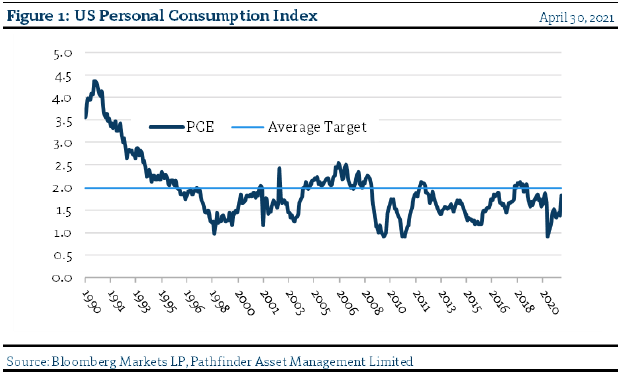Inflation Asset Strategy: Areas to avoid
This week, we received some important data from the US government that we thought we would point out: The Core Personal Consumption Expenditures Index (PCE), which tracks the overall price changes for goods and services purchased by consumers. It is the preferred measure of inflation used by the US Federal Open Market Committee (FOMC) to set administered interest rates, which form the basis of the US Feds management of economic support and ultimately form a major input into inflation expectations. The FOMC has previously issued a hard target of 2.0% for PCE but more recently has changed that to an “Average Target: of 2%”, which would allow inflation to “run hot” to balance out the long periods of disinflation that we have experienced since the Great Financial Recession of 2008. Figure 1 presents that while the PCE level has dropped since the 90’s and mostly stayed below 2%, it appears to be rising recently. Where it goes from here is the crux of the debate. If it goes uncontrollably higher, then there are certain types of companies that might be at risk as their industry or business structure will make it harder for them to maintain stable margins.

- In general, we would like to avoid companies that have “bond-like” characteristics, which means that they have limited ability to adjust prices higher to protect their profit margins in a rising price environment.
- For example, large electric utility companies in Canada are regulated by the government and are able to charge a rate to clients that allows them to earn a regulated return on their assets. The rate is set by the government in consultation with the companies and consumer stakeholders. This means that there is a lag between an increase (or decrease) in allowable return as interest rates change. Unfortunately, the drop in regulated return seems to be quicker in a decreasing rate environment than the increase is in a rising rate environment. As the companies are not allowed to pass on price increases to customers as inflation rises, the cash flow for the owners of the assets (the shareholders) is compressed resulting in poor operating performance.
- Another example would be a pipeline company where, again, the government sets a rate for transportation of liquids or gas and the company has to apply to a regulator to increase the rate as costs increase. This application process can result in a limited ability to adjust in a fast-moving environment, which could impair cash flow.
“This means that” as inflation expectations change, we have options as investors to identify companies that provide real protection. We should also be mindful to allocate capital away from those organizations that are at a disadvantage. Fundamental company specific analysis will provide opportunities and help us avoid problems.
National Instrument 31-103 requires registered firms to disclose information that a reasonable investor would expect to know, including any material conflicts with the firm or its representatives. Doug Johnson and/or Pathfinder Asset Management Limited are an insider of companies periodically mentioned in this report. Please visit www.paml.ca for full disclosures.
*All returns are time weighted and net of investment management fees. Returns from the Pathfinder Partners’ Fund and Pathfinder Real Fund are presented based on the masters series of each fund. The Pathfinder North American Equity Portfolio and The Pathfinder North American Income Portfolio are live accounts. These are actual accounts owned by the Pathfinder Chairman (Equity) and client (High Income) which contain no legacy positions, cash flows or other Pathfinder investment mandates or products. Monthly inception dates for each fund and portfolio are as follows: Pathfinder North American Equity Portfolio (January 2011), Pathfinder North American High-Income Portfolio (October 2012) Pathfinder Partners’ Fund (April 2011), Pathfinder Real Fund (April, 2013), and Pathfinder International Fund (November 2014).
Pathfinder Asset Management Limited (PAML) and its affiliates may collectively beneficially own in excess of 10% of one or more classes of the issued and outstanding equity securities mentioned in this newsletter. This publication is intended only to convey information. It is not to be construed as an investment guide or as an offer or solicitation of an offer to buy or sell any of the securities mentioned in it. The author has taken all usual and reasonable precautions to determine that the information contained in this publication has been obtained from sources believed to be reliable and that the procedures used to summarize and analyze such information are based on approved practices and principles in the investment industry. However, the market forces underlying investment value are subject to sudden and dramatic changes and data availability varies from one moment to the next. Consequently, neither the author nor PAML can make any warranty as to the accuracy or completeness of information, analysis or views contained in this publication or their usefulness or suitability in any particular circumstance. You should not undertake any investment or portfolio assessment or other transaction on the basis of this publication, but should first consult your portfolio manager, who can assess all relevant particulars of any proposed investment or transaction. PAML and the author accept no liability of any kind whatsoever or any damages or losses incurred by you as a result of reliance upon or use of this publication.